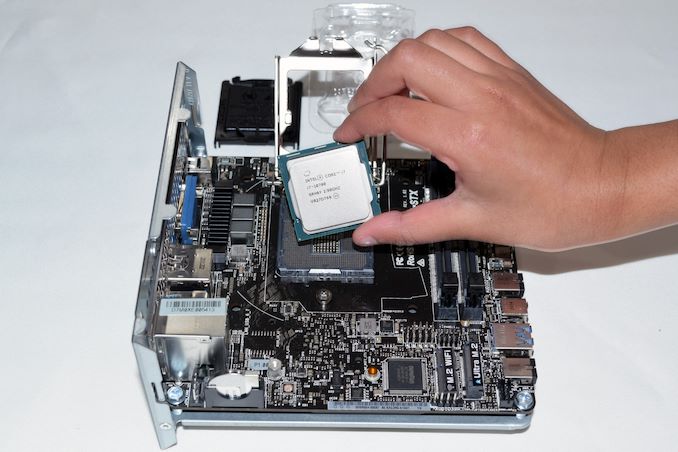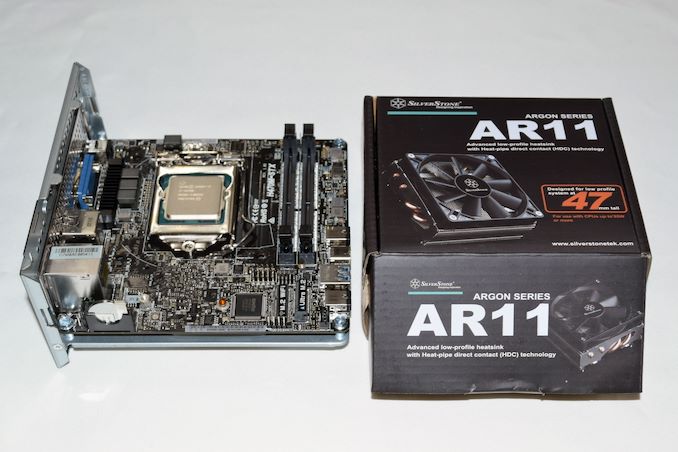ASRock DeskMini H470 Review: A No-Frills LGA 1200 mini-PC Platform
by Ganesh T S on December 29, 2020 8:00 AM ESTConcluding Remarks
The ASRock DeskMini H470 gave us the opportunity to check out what is possible with the mini-STX form factor and a regular-TDP Comet Lake desktop CPU. The H470 supports a wide range of 10th Gen. desktop processors, and given the trend of Intel maintaining socket compatibility for at least a couple of generations, we expect it will support the upcoming 11th Gen. Rocket Lake-S CPUs also. In fact, ASRock already seems to have put in support for the CPU-attached storage-focused PCIe 4.0 x4 lanes in the board.
Intel's mSTX form-factor started off with affordability in mind - a reason why the initial mSTX boards were based on the H x10 chipsets. Starting with the 300-series, vendors have moved on to create systems based on the H/Z x70 PCHs, providing more scope for innovation. For example, the DeskMini H470 BIOS has plenty of features that are based off the options available in the BIOS of their full-featured motherboards - including overclocking capabilities. The mini-STX form factor is not amenable for gaming use-cases (ASRock does have the micro-STX Z370-based offerings in the DeskMini series for that market), as the integrated GPU in the 10th Gen. processors is not suitable for extensive gaming. Yet another legacy of this affordability mindset is the absence of a level-shifter on the board to enable HDMI 2.0 / 4Kp60 capabilities on the HDMI port. The chassis is well-ventilated, but the lack of any noise dampening means that the system is not as quiet as what one would expect from a HTPC. The DeskMini H470 has its own target market in the DIY space among PC builders interested in experimenting with SFF PC systems.
The pricing for the DeskMini H470W is very competitive - $190 for the all-metal chassis, 120W power adapter and cord, H470 motherboard, and a Wi-Fi 5 Intel Wireless-AC AC3168 card (Note that our review sample was the non-W version without the WLAN card). While the assembly is not as easy as that of a NUC, it is acceptable for the DIY market.
The mini-STX form-factor allows users to install powerful desktop TDP-class processors in a compact, yet, flexible machine. ASRock has put in plenty of thought into the BIOS as well as feature set. With a bit of an additional premium, ASRock could have also made more of the USB ports present in the front and rear panels to be USB 3.2 Gen 2 (10 Gbps) - the H470 PCH does support up to four 10 Gbps ports and eight 5 Gbps ones. The PCIe 3.0 x16 lanes from the processor are also left unused due to the absence of discrete graphics support. A game-changing feature would have been the addition of a couple of Titan Ridge Thunderbolt 3 controllers hanging off some of those lanes. This would allow the end users to use an eGPU later on in the product's lifetime An additional dock to provide some needed I/O functionality like a SD card reader or additional USB ports would have also been made possible. I think the market would find it OK to even allow a $50 premium over the current pricing for such a feature set. In the end, the affordability factor and the resultant pricing pressure make the DeskMini H470 a no-frills machine in terms of I/O capabilities.
The DeskMini H470 is one of the very few small form-factor systems in the market allowing end-users to choose their own processor for installation. Intel has 10th Gen. CPUs with different TDPs (ranging from the $50 2C/2T Celeron G5900T with a TDP of 35W to the $450 10C/20T Core i9-10900 with a TDP of 65W) that are compatible with the ASRock DeskMini H470. The board designed by ASRock is easily able to sustain the 65W package power consumption in the Core i7-10700 that we tested with.
One of the most surprising components of the build was the Silverstone SST-AR11 heat sink that we ended up using in the absence of the box fan cooler that usually accompanies a retail Core i7-10700. In our last Intel-based DeskMini review (the DeskMini 310 back in March 2019), we had used the Core i3-8100 with a 4C/4T configuration and the same 65W TDP. Despite consuming much less power at the wall and package levels compared to the Core i7-10700 in the DeskMini H470, the temperatures with the stock cooler went above 70C during the segment where both Prime95 and Furmark were active. In contrast, the SST-AR11 was able to keep the CPU package quite cool (below 60C) for the same segment despite the higher package power dissipation and at-wall power consumption. The DeskMini 470 could have done with a better cooling solution for the voltage regulating circuitry too - that would have allowed us to recommend experimenting with the base frequency boost BIOS option.
ASRock's BIOS quality and feature set in the mini-PC space is perhaps surpassed only by Intel in their top-end NUCs (such as Skull Canyon and Ghost Canyon). There are plenty of tweaks available for overclockers (though motherboard hardware limitations might restrict some usage aspects), and value-additions such as the ability to update the BIOS without having to download an installer or BIOS file into a separate USB drive are quite welcome.
Another checkmark in the win column for ASRock's mSTX box comes down to cost: the highly integrated box is a surprisingly cheap option. While mini-ITX H470 motherboards themselves are quite cheap ($120 for ASRock's own H470M-ITX/AC), once the cost of a good mini-ITX case, power supply, VESA mounts etc. are taken into consideration, the build pricing starts to approach that of the $190 barebones DeskMini system; so unlike NUCs, there's no premium for size here. Which is great, because with mSTX systems being so much more compact than mITX systems, this opens the door to installing them in places even mITX systems can't fit in.
Overall, ASRock's DeskMini H470 gives plenty of scope for build experimentation while delivering a no-frills PC that fulfills the basic requirements one might have from a build for productivity purposes. As long as the limitations (that might not be applicable to a majority of use-cases) outlined in this review are understood, the DeskMini H470 is bound to fulfil the expectations of consumers. In our opinion, the DeskMini H470 strikes a good balance between cost and features, and we have no qualms in recommending it for specific use-cases as good value for money.













26 Comments
View All Comments
Tomatotech - Tuesday, December 29, 2020 - link
That’s possibly one of the best possible arrangements for the m.2 slot then as the metal tray will be an excellent heat sink. You could even add a bit of thermally conductive foam (make sure it’s not the electrically conductive type) to help with heat transfer to the tray.ganeshts - Tuesday, December 29, 2020 - link
The Ultra M.2 slot is on the top side of the board. That is the one used with Comet Lake CPUs. The slot you are referring to is the Hyper M.2 (PCIe 4.0 x4) slot which is usable only when the Rocket Lake CPUs come around.twotwotwo - Tuesday, December 29, 2020 - link
Its AMD relative the A300 was my main machine for a while, and had it been easier to get Zen 2 desktop APUs I might still be using it. Quiet (given a decent fan), cheap, tiny (obvs), reasonably expandable, gets the job done--about all I can ask for from a work desktop.Death666Angel - Tuesday, December 29, 2020 - link
The 4000 Series Pro APUs are pretty well available in Germany, from reputable online retailers. I can get the R5 Pro 4650G for 20% more than the equivalent R5 3600 (200€ vs 240€ roughly). That would be my sweet spot, personally. For 8 cores it's also roughly 20% (280€ vs 340€) but for that price difference, you could get a nice used GPU already that will maybe game better. I personally could never justify a GPU-less build, although I am eternally curious about them and plot one out once every couple of months.... and then I look at benchmarks of dGPU vs iGPU and stop. :DTomatotech - Tuesday, December 29, 2020 - link
I didn’t see it in the article so here are the specs:155 x 155 x 80 mm (1.92L)
Not bad, though for most low to mid-level use cases it’d be far cheaper to buy a used Lenovo or Dell USFF PC - these have even less volume at around 1.1L but are slightly larger and flatter (around 180x180x35mm)
For SFF with GPU I still prefer something like the K39 mITX chassis on the low end which comes in at 3L but allows you to use most full-sized GPUs (but for now possibly not the nVidia 3000 series).
Samus - Tuesday, December 29, 2020 - link
I've been rocking the FT03-Mini and while it is an absolute nightmare to work inside of (and I question my sanity for why I put myself through owning it) it is still a very effective ITX chassis for the size, capable of 10.5" videocards, multiple hard drives (plus two m2 drives you can mount to most current motherboards) while using a single 140mm fan to cool everything. Realistically the highest TDP CPU you want to use is around 88-watts as anything more you will stress any closed loop cooler with a 25mm radiator (the max the case can accept) and need to go to a heatsink of some sort with another dedicated fan.Obrut - Tuesday, December 29, 2020 - link
It will be interesting to see a comparison with ASRock Jupiter H470, which has a much different form factor and cooling solution.M O B - Tuesday, December 29, 2020 - link
I have a Deskmini 310w--is the UHD 630 on 10th gen CPUs any faster than the UHD 630 on older CPUs?If not, then it seems like this iteration basically adds some USB 3.0 ports versus my current build.
ganeshts - Wednesday, December 30, 2020 - link
I think the additional angle here is that of a low-cost platform that can take advantage of the RKL-S CPUs coming in 2021. Personally, I also think it is not a great choice to upgrade for those who already have the 310. It is meant more for folks getting their first mSTX machine.Samus - Tuesday, December 29, 2020 - link
I had the SST-AR11 cooler in my Silverstone FT03-Mini and was pretty disappointed (partially due to the chassis inherently poor ventilation) and equally disappointed by closed-loop coolers due to the 25mm thickness limitation of radiators. After spending seemingly hundreds of dollars and way too much time hunting for a thermal solution, some forum posts directed me to try the NT06-Pro, which would theoretically fit this mSTX chassis as long as there is no interference with the power supply.It performs incredible well as you position the fan under the fins and blow the heat away from the motherboard instead of onto it, giving it somewhat of the beneficial effect of a tower-style cooler.